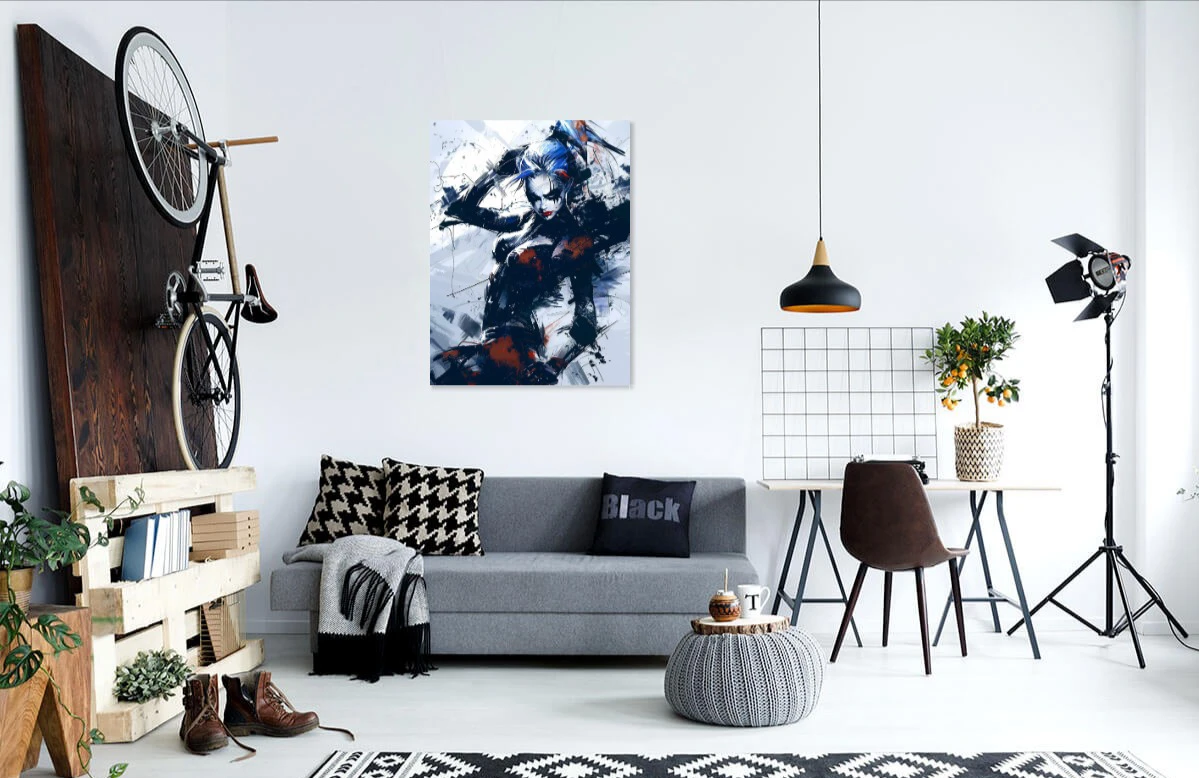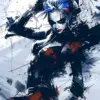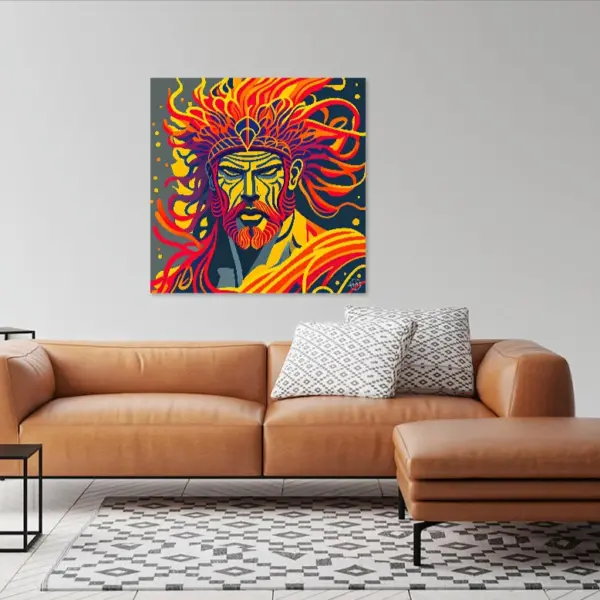Harley Quinn Dilemma: Chaos in Control
Harley Quinn, as depicted here, is both familiar and transformed. The recognizable elements of her character are still present—the pale face marked by bold black and red makeup, the vivid blue streak in her hair, and the signature sense of playful rebellion. But instead of the usual comic book caricature, the artist presents her in a way that feels far more raw and primal. This is Harley stripped of her veneer, an incarnation more aligned with madness than mischief. Her eyes, shaded in black smears of makeup, are wide and penetrating, staring out of the canvas with an unsettling intensity. They seem to challenge the viewer, daring us to understand the inner conflict bubbling beneath her controlled exterior.
The composition of the piece mirrors Harley’s dual nature—the chaotic, violent splatters of paint juxtaposed against the sharp, precise lines of her figure. The strokes of blue and black slash across the canvas with aggression, giving the impression that her very existence is tearing through the fabric of the painting. It’s as though she’s trying to break free, not just from the bounds of the artwork but from her own inner turmoil. The blood-red accents are smeared across her body like battle scars, not gory but symbolic of the internal war she constantly fights.
The most striking element of the painting, however, is the posture. Harley’s hand is poised at her temple, as if she’s saluting or pulling at her hair in frustration. It’s a gesture that encapsulates the dilemma hinted at in the title—a moment caught between thought and action, between calm and chaos. Is she preparing for battle, or is she collapsing under the weight of her own instability? The artist leaves the answer ambiguous, forcing the viewer to confront the tension within themselves. It is a visual manifestation of Harley’s constant balancing act between being the villain and the victim, the puppet and the master.
The background is a swirling abstraction, fragmented lines and shapes that bleed into one another, reflecting the storm that surrounds her mind. It’s as though the environment itself cannot stay intact under the pressure of Harley’s presence. There’s no ground beneath her, no clear sky above—only the whirl of madness. And yet, within this disarray, she stands tall, composed in her own way. The world around her may be disintegrating, but Harley remains at the center, both its cause and its survivor.
This depiction of Harley Quinn is a reflection on identity in flux. She is simultaneously powerful and powerless, a figure of strength and fragility. The sharpness of her body, cutting through the chaos, speaks to her resilience. Despite the disorder surrounding her, she is in control—or at least, she wants us to believe she is. The question that lingers is whether this control is real or simply part of the grand delusion she lives in. The tension between sanity and madness is not resolved here—it’s left hanging, as it should be, because Harley’s very essence thrives on this uncertainty.
In Harley Quinn Dilemma, the artist has succeeded in capturing more than just a portrait of a character. They have delved into the complex psyche of Harley Quinn, portraying her not as a caricature but as a deeply human figure struggling against herself. The painting doesn’t ask us to pity her, nor does it glorify her rebellion. Instead, it invites us to witness the tension, to see the cracks in the persona, and to feel the weight of her existence as a constant battle—a dilemma that may never be resolved.

This artifact boasts a resolution of 300dpi and measures 70cm (27.5in) on its longest side. It is an excellent way to showcase your style and personality on your wall, adding character to your space. It makes for a unique and lasting gift. Printing at these dimensions will result in high-quality prints. Doubling the dimensions will allow for larger prints suitable for interior decoration. We have provided some artifact sizes based human size to give you an idea.
Looking to purchase art from our online gallery? Follow these simple steps:
- Find the artwork you love and click on it. If you're considering multiple pieces, click "ADD TO CART." If you've decided on just one, click "BUY NOW."
- Feel free to keep browsing our gallery and adding more artwork to your cart.
- To review your selected artworks, click on the shopping cart icon in the top right corner. You can remove any items if you change your mind.
- When you're ready to complete your order, click "CHECKOUT" at the top right corner of the screen.
- After your purchase, you'll receive a download link. Additionally, we'll send the link to your email address for easy access.
Wondering how to pay for your selected artworks? Here's how:
Simply click the "CHECKOUT" button to finalize your order, and then select your preferred payment method. We offer the following options:
- Credit cards (Stripe)
- PayPal
- Bank transfer (Upon placing your order, we'll send you an invoice. Once the invoice is paid in full, we'll proceed to ship the artwork.)
Is the payment secure?
- Rest assured, our payment system is highly secure. We exclusively process transactions that are 3D secured to combat fraud.
- Additionally, as an added measure of protection, we may request identity verification to prevent unauthorized use of your credit card.
Is it possible to request a commissioned artwork with specific size and color preferences?
- Interested in commissioning an artwork of a specific size or color? While not all artists offer commissions for paintings and sculptures, you can request a customized size print.
- Feel free to reach out to us and share your requirements if you're interested in commissioning an artwork. We're here to assist you.
Shipping & Returns?
Purchase Terms of Agreement
The purchase of digital products, including EPS, PDF, AI or JPG downloads and online material is subject to the following terms and conditions. Consumers are advised to review carefully before making any purchase
Payment + Refund Policy
All transactions for purchase of intangible products, pdf, eps, ai or jpg downloads, resource material, and online content are made through payment gateways such as PayPal or Stripe that use SSL encryption. These payment gateways are safe and secure for using all types of credit cards and debit cards in different countries and your details are not stored during this process.
Since your purchase is a digital product, it is deemed “used” after download or opening, and all purchases made on www.daymara.com (Swiss Llc Ltd.) are non-refundable or exchangeable. However, we will provide a full refund if the resolution, print quality, if you have received a product that differs from the product image shown to you at the time of purchase or if there are file errors. Since the products made available here are intangible, there is a strict no refund policy.
Daymara (Swiss Llc Ltd.) reserves the right to amend any information, including but not limited to prices, technical specifications, terms of purchase and product or service offerings without prior notice.
Delivery of Goods and Services
If you do not receive the digital product link upon purchasing, you can immediately contact day@daymara.com with your transaction/payment details to ensure your product is delivered as soon as possible.
Delivery Process
- The product you purchased is a print-ready visual design product.
- A download link of the product will be presented to you after the purchase. You will be able to download and use the work using this link.
- Delivery is provided with a downloadable link after purchase. Also, no physical product will be sent. Please make sure you understand this point. If you have any questions, please write to us from the contact section.
- Each product may be in different sizes. The maximum printable size of the product is written on the page of the product. It is naturally possible to print larger than this size. But in this case, pixel distortions can be seen.
- Since a downloadable link is offered to you after purchasing the product, the product you have purchased is deemed to have been delivered.
- It is not possible to return the delivered products or cancel the order after this stage. However, we will provide a full refund if the resolution, print quality, if you have received a product that differs from the product image shown to you at the time of purchase or if there are file errors.
- If you encounter a problem with the file you downloaded, please do not hesitate to contact us. Your request will be answered within 1 hour at the latest.






 70-140cm (27.5″≈55″) Printable
70-140cm (27.5″≈55″) Printable

